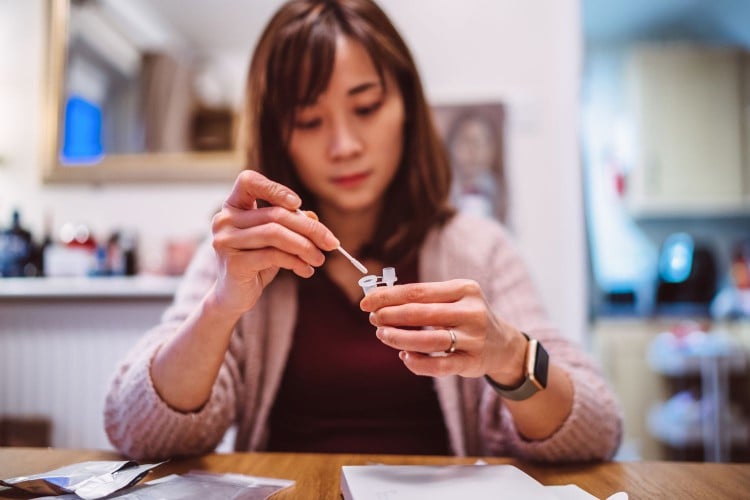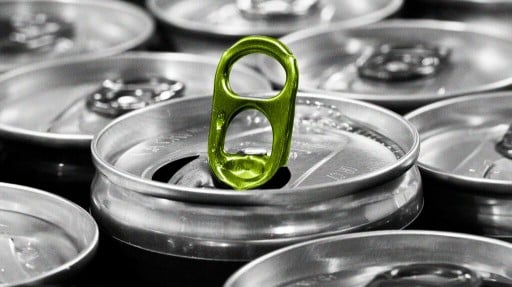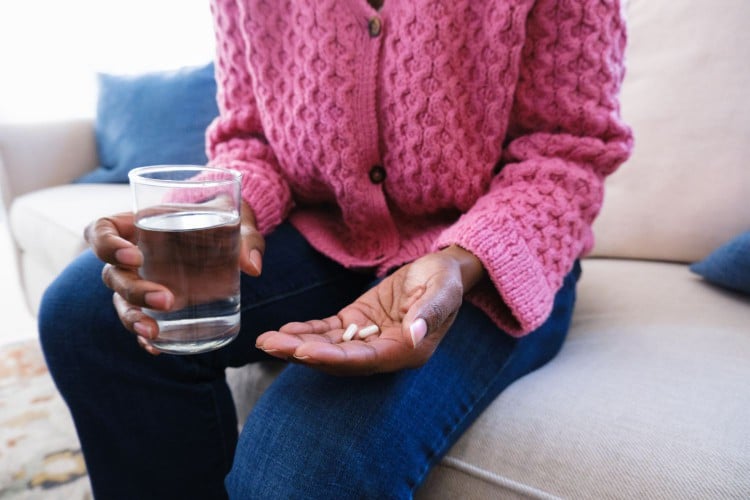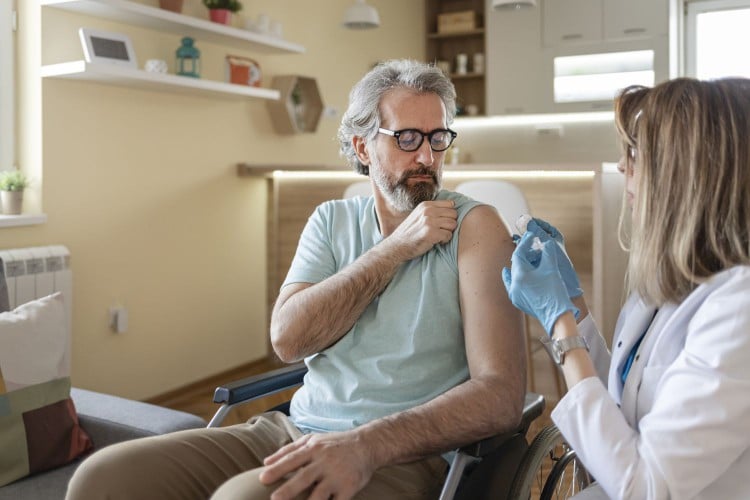- A new Centers for Disease Control and Prevention (CDC) report shows that a new Omicron variant, JN.1, is on the rise.
- JN.1 appears to be very symptomatically similar to another Omicron strain—BA.2.86.
- Experts recommend people stay up-to-date on their COVID boosters and practice other precautionary measures to stay healthy this holiday season.
A new Omicron variant—JN.1—may be on the rise.
According to updated data from the Centers for Disease Control and Prevention (CDC), COVID-19 levels are spiking in the U.S.
Recent data shows a 17.6% rise in COVID-related hospital admissions, as well as a 25% rise in COVID deaths. Test positivity and emergency room visits have also increased, at less drastic rates.
Last Friday, the CDC published an update on the JN.1 Omicron subvariant. The strain now makes up between 15% and 29% of current COVID cases. In late October, JN.1 made up less than 0.1% of cases.
According to the CDC, this rise indicates that JN.1 may be more transmissible than other strains.
However, the new report stressed that “we do not know to what extent JN.1 may be contributing to these increases or possible increases through the rest of December.”
That said, experts are concerned about the combination of holiday gatherings, low COVID vaccine rates, and a new, transmissible variant.
“We have a little bit more population immunity, which is making it so that it’s not going to be like 2020 and 2021,” Jill Foster, MD, division director of pediatric infectious diseases at the University of Minnesota Medical School, told Health. "But I think we’re [not in] a good place right now."
Here’s what you need to know about the JN.1 subvariant, how the strain might be affecting the current COVID situation in the U.S., and how to stay safe this holiday season.

Getty Images / Images By Tang Ming Tung
The JN.1 Variant Is Similar to the BA.2.86 Variant
JN.1 is closely related to another Omicron strain—the BA.2.86 variant—that experts were monitoring earlier this year.
Actually, the only change between BA.2.86 and JN.1 is in the spike protein.
While there are still a lot of unknowns about the latest Omicron strain, experts expect JN.1 to continue to pick up momentum.
“It’s causing nearly a third of new cases in the U.S., and it’s very likely to be the dominant variant with us through the holidays,” Mark Cameron, PhD, associate professor and infectious disease researcher at the Case Western Reserve University School of Medicine, told Health.
As far as symptoms are concerned, the CDC expects JN.1 to have similar severity and symptoms to other Omicron variants.
Foster shared anecdotal reports from colleges that newer variants, like JN.1, tend to produce more gastrointestinal symptoms, such as abdominal pain or diarrhea. However, that has not been confirmed by the CDC.
For now, the public health risk caused by JN.1 appears to be similar to other Omicron variants. But, pre-print data from researchers in Japan suggests that JN.1 has the potential to be skilled at evading the immune system.
“Anytime you have a new virus emerge, it has to be better than the old virus,” said Foster. “It’s either better at evading immunity or something about it makes it better at spreading.”
What to Know About the New HV.1 Variant
Is JN.1 Driving this Current COVID Spike?
In addition to increases in COVID-related hospitalizations, deaths, emergency room visits, and infections, the U.S. is seeing generally “high” COVID numbers.
Nationally, COVID activity is the highest it’s been so far this year. The risk varies by region—the Northeast and West are seeing lower levels, while the Midwest is currently seeing its second-highest COVID peak ever.
Experts say it’s still too early to tell if JN.1 is to blame for these levels.
The increase in cases could simply be the normal ebb and flow of COVID—it tends to increase and peak in late summer, and then again around the new year, the CDC said.
“We all cluster indoors together at the same time the viruses get introduced,” said Foster, making infection rates for respiratory viruses generally worse in colder months.
However, JN.1’s quick increase raises the question of whether it could be driving an increase in infections going forward.
Cameron explained that the general increase in COVID infections means that the virus is now reaching a wider range of people, many of whom are more vulnerable to severe disease. So even though these numbers are ticking up in tandem with JN.1’s rise, it doesn’t necessarily mean that the variant is more deadly.
While this year’s COVID increase isn’t completely abnormal, experts are still concerned about what the data has shown so far.
“The thing I think is going to be different this year than last year, is people really are not doing any risk mitigation,” Foster said.
As of mid-November, survey data from KFF indicated that just one in five Americans has received the updated COVID shot. A Yahoo News/YouGov poll from August found that only 12% of Americans say they mask most of the time in public.
This, coupled with JN.1 and holiday gatherings, could make this year’s wintertime peak a “perfect storm,” said Foster.
When Should You Test for COVID After Symptoms Appear? New Research Has the Answer
Staying Safe This Holiday Season
Because JN.1 is so similar to BA.2.86 and other Omicron variants, all signs point to current COVID tools—vaccines, tests, and treatments—being effective against the strain.
Still, that doesn’t mean it’s completely harmless.
“[A JN.1 infection] might be a mild case, a moderate case, or a case that could put someone in the hospital—that’s really a product of our genetics, our immune system, and our history not only with COVID-19, but with other infections,” said Cameron.
Because of this variability, it’s essential that people do what they can to avoid infection this holiday season.
“It really is this proportion of people in the U.S. [not] keeping up with their booster series that really concerns me,” said Cameron. “It does show a bit of complacency with the virus continuing to evolve against us.”
Foster noted that people won’t likely be wearing masks at family gatherings or holiday parties. But that doesn't mean it's not worth considering.
“The biggest thing people can do is, when they’re in crowded places around a lot of strangers, they wear a mask,” said Foster. In particular, people should consider masking while grocery shopping or traveling, she explained.
In terms of holiday gatherings with friends and family, Foster recommends asking anyone who’s sick to stay home. People don’t need to show a negative test at the door, she said, but it’s best not to power through and attend a gathering while you’re sick.
Still Haven't Gotten Your Flu and COVID Shots? Now's the Time, CDC Director Says








